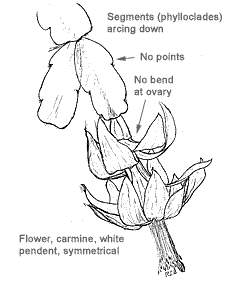
Many people like to get their gardening friends plants for the holidays. I personally like fruiting plants (hint, hint), even if they don't have fruit on them at the time. Most people like to give flowering plants. This time of year there are a few options: camellias are flowering and some stores sell Amaryllis or paperwhite bulbs that have been forced into flower. One of my favorite flowering plants however, is the “holiday” cactus.
Why, do you ask, did I call it a holiday cactus? Aren't Christmas cactus' being sold now?
Maybe yes, maybe no. This is one of those questions that have been plaguing mankind for years. Do you have a Christmas cactus or an Easter cactus or is the darn thing a Thanksgiving cactus?
Let's see if we can answer this. The main difference between the Christmas, Thanksgiving, and Easter cacti is their time of bloom. As their common names suggest, a Thanksgiving cactus can bloom in late fall, one month before the Christmas cactus. The Easter cactus starts producing flower buds in February. This is because they're relying on the day/night length and temperatures. Let's say that you are keeping them as houseplants and they can't see outside through the drapes? There is another way to tell the different cacti apart.
This is the Christmas cactus:

The true Christmas cactus does not have the points on the sides, but are still bumpy. The Christmas cactus is Schlumbergera x buckleyi, a hybrid plant produced in the late 1840s by William Buckley at the Rollisson Nurseries in England.
THANKSGIVING CACTUS
The actual Thanksgiving cactus, the plants most often sold as "Christmas cacti" (by which name they sell best) are Schlumbergera truncata cultivars. These are clones selected for their colors and growth habit and given cultivar names. They bloom about a full month or more before the true Christmas cactus and given the same treatment, so they are more easily made to bloom at the best time for early Christmas sales. The flowers might not last until Christmas though. They are also known by many popular names such as "link cactus", and "Grandmother's cactus." Like I mentioned, these clones have been selected and bred for their many colors. They can come in lavender, white, fuschia, red, orange, and all shades in between.
This is a Thanksgiving cactus

As you can see, there are a little bit more defined "points" on the sides.
EASTER CACTUS
The Easter Cactus is Rhipsalidopsis gaertneri. In some respects it is very similar to the Schlumbergera. However, it blooms in April (around Easter) and its flower is very different. It is not nearly as popular as the Thanksgiving or Christmas cacti because it is a little bit more difficult to grow, and it has the nasty habit of shedding its phylloclades (stem segments) at the slightest drought, or whenever over-watered. It may also refuse to bloom for no apparent reason.
This is an Easter Cactus

As you can see, the edges are almost smooth and the flowers are very different.
HOW TO CARE FOR YOUR CACTI
Flower bud initiation in Thanksgiving and Christmas cacti start in response to cool temperatures and shortened day length so they should be left outdoors, away from artificial light until night temperatures dip into the 40s. At this time, they do best at temperatures between 50 and 65 degrees. The Easter cactus requires a dry period. From October to November, very little water is required for flower bud initiation. Easter cactus can be placed in the same cool area as the Thanksgiving and Christmas cacti. In December, raise the temperature to about 65 degrees and water sparingly.
All three Holiday cacti can be propagated quite easily by removing a single segment and planting it a quarter of its length deep in a pot filled with slightly sandy soil. It helps to put some kind of rooting hormone on the base of the cutting. Place the pot in a well-lit area (but not in direct sunlight) and keep the soil moist. The cutting should begin showing signs of growth after two or three weeks.
They all have the same basic needs:
— The soil should be evenly moist for best growth, but they are intolerant to constantly wet soil.
— They will do best in bright indirect light. Long-term direct sunlight can burn the leaves and stunt growth.
— A well-balanced general fertilizer applied once or twice a year is usually all that is needed.
— Unless the plants outgrow their containers, you can usually get away with repotting every two to three years. The flowering can actually be encouraged by the plant being somewhat pot bound. If soil quality deteriorates rapidly, you might consider repotting more often. One of the best soil mediums to use is African Violet soil.
— There are not many pests that bother Holiday cacti, other than Mealy Bugs. One easy solution is to touch each insect with an artist's brush or Q-tip dipped in rubbing alcohol. Heavier infestations can be treated with a strong spray of water or Insecticidal Soap, repeated at about weekly intervals. If this doesn't work, a Malathion spray should do the trick. Be careful with the strong spray of water however, the joints of the plants are quite fragile and can break apart if the plant is handled too roughly.
My mother and grandmother always had the most beautiful "Christmas Cactus" when I was growing up, of course, now I know they were really Thanksgiving cactus. I remember marveling at the pretty flowers. View the photos above to see what I mean.
I hope you all receive a Thanksgiving or Christmas cactus as a gift from a loved one this holiday season, if not, go out and buy yourself one. You deserve it!
Happy Growing!
Darren